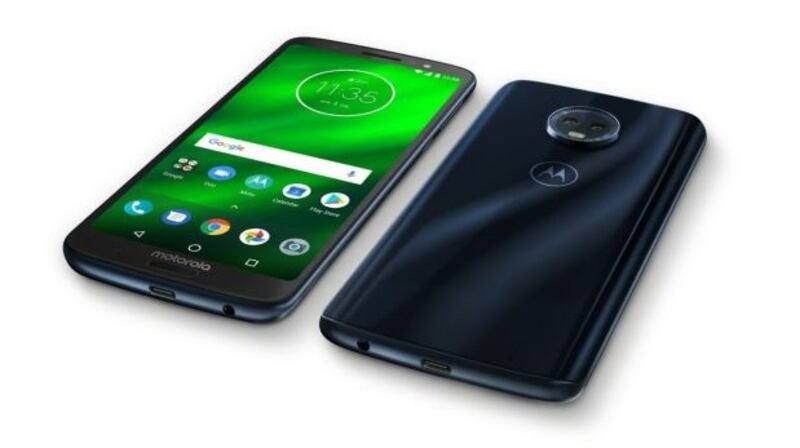In the market for a new phone but can’t justify the flagship prices? There are still plenty of options out there, ranging from the “just above budget” phones to mid-range handsets that don’t sacrifice too many features to keep costs down.
Vodafone Smart
€130 on prepay
Vodafone’s own-brand smartphone is swimming in a pretty crowded pool. The Android handset has one thing its favour: it is budget in price, but not in features, for the most part. The screen is a 5.5-inch HD+ display, and the design means the bezel has been cut down as much as possible. It has a 3000 mAh battery too, which isn’t as large as some of the rest but it will keep you going for most of the day at the very least.
And if aesthetics are an important consideration, the N9 combines glass, metal and detailed finishes to produce something that doesn’t look like its price tag suggests.
Where it scrimps
The camera isn’t its strongest feature, although it is fine in normal light. The 13 megapixel sensor struggles when conditions are less than ideal though.
Where it shines
You can’t really beat the Smart N9 on price. Sure, it has a couple of issues, but it is by far the cheapest in this round-up without completely sacrificing features. The screen is better than you’d expect for the price too.
Moto G6
€250
The Moto G is a regular feature on the “best mid-range handsets” list. In fact, with a price that tips towards the lower end of the scale but a spec that puts it in contention with the best middle of the road phones, the G has always been a bit of a bargain. We are now up to the sixth generation – hence the G6 moniker – and the phone has only been getting better.

This comes in at the lower end of the scale, hovering around the budget end of things, but it surpasses its price tag. A 5.7-inch display, a decent resolution on the camera and enough RAM at 3GB to run moderately taxing tasks make this a good all-rounder.
Where it scrimps
Most phones on the market these days are water-resistant; the Moto G6 is not, so keep it out of the pool, sink or toilet. It also skips wireless charging, and uses a lower-powered chip, which can show if you really try to push the phone too hard.
Where it shines
The full HD display is bright and detailed, and the design is far removed from its budget price tag. The camera produces some good photos too, despite this being another area where budget phones can fall down.
Nokia 7.1
Nokia has really turned things around. A few years ago, the brand was struggling, facing total extinction in the smartphone market. But HMD Global has managed to resurrect the former king of the smartphones. While it hasn’t reached the peak it saw before the advent of the iPhone, it has managed to bring out a few gems of phones that are worth paying for.
The Nokia 7.1 is the latest of its phones to hit the market, and it continues the company’s streak of decent phones that could help it carve out a half-decent market position for itself.
Where it scrimps
Internal storage is minimal at 32GB. You’ll need to invest in a memory card to expand the space you have, unless you want to spend half your life deleting photos and images. It ships with Android Oreo, which isn’t the latest version of the operating system, but that’s not to say that it won’t come later.
Where it shines
From the big, bright display to a camera that wouldn’t look out of place in a more expensive phone, the Nokia 7.1 doesn’t let the side down. Plus it has a decent battery that should get most users – apart from the more intensive ones – through the day.
Samsung A8
€400
Samsung may give most of its attention to the flagship Galaxy S9 and Note ranges, but it has other, less budget-busting options. Take the A8 for example. The phone is a much simpler Android handset, both in its design and its spec, but there is plenty to like about it. Not least of these is the fact that it is far cheaper than the flagship Galaxy S9 but has a lot of features that you would expect to find in a more expensive phone, such as an OLED screen.
Where it scrimps
Designwise, it’s a bit uninspiring. The camera struggles a little in low light, and it only comes with 32GB of storage on board.
Where it shines
That screen may not be quite the quad HD super AMOLED of the S9+, but it is bright, and it’s responsive. When conditions are right, the camera produces some great photos.
Huawei P20
€550
Huawei has been trying to claw its way to the top of the smartphone pack by building better cameras in smartphone cases that don’t push the design boundaries too much. The P20 is the little brother of the P20 Pro, and although it loses a few features, it is more than capable of holding its own. The Android phone has a 5.8 inch display, and 128GB of space to store photos and videos. It uses Huawei’s own Kirin chip to run things too.
Where it scrimps
If you have been looking forward to those excellent low-light shots, you should know that the P20 has a dual rather than triple camera. That means it’s not quite as impressive in the photography stakes as its sibling. It also leaves out wireless charging – though that is something Huawei has introduced with the recently announced Mate 20 Series. It’s also an LCD display instead of OLED, and there’s no way to increase physical storage.
Where it shines
The camera may not be quite up to the standard of the P20 Pro, but it’s still a great still and video camera. And you are unlikely to notice the slightly smaller screen on the P20 anyway. Designwise, it’s a nice phone, with Huawei doing its best to shrink the bezels as much as possible. More screen for your phone case is always a good thing.
OnePlus 6
From €519
One of those phones that serves up a mid-range price with close to flagship specs, the One Plus continues to deliver with an excellent screen, a fantastic camera and great performance. It has a 6.28-inch display, a 16-megapixel and 20-megapixel dual camera, and up to 8GB of RAM. Bonus: it keeps the audio jack, so no need to hunt around for decent bluetooth headphones if you don’t already own a set. What it doesn’t do is rely heavily on AI for the camera, which means you might not get as good photos as other phones unless you are a bit more talented with a lens. But the lack of AI shouldn’t put you off.
Where it scrimps
If you want expandable memory, you need to look elsewhere. The One Plus has no slot for a memory card so you need to be content with what you get, which is up to 256GB. And although the camera is great for a mid-range phone, but the One Plus 6 may struggle against the flagships.
Where it shines
Almost everything else. Performance-wise, the One Plus 6 is excellent. Put it beside a cheaper, less well-equipped phone and you’ll notice the difference. That screen is excellent, and Dash Charge is useful for a quick power boost, considering the One Plus 6 doesn’t include wireless charging.
Apple iPhone XR
€879
On its way – due for release on October 26th – is the iPhone XR, the third iPhone that Apple unveiled last month alongside the Xs and Xs Max. The XR comes with a 6.1-inch screen, the A12 bionic chip and Apple’s Face ID to unlock the phone. It’s got a glass back, and comes in a better range of colours than the Xs or Max. If you want a phone that expresses your personality better than in terms of silver, space-grey or gold, the XR is a good bet.
Where it scrimps
The XR swaps out the OLED screen of the Xs for a plain LCD. The good news? You’re unlikely to notice, unless you have the phones side by side. It also skips out the dual camera in favour of a single camera. And when you look at the price tag, it’s not really that cheap. It’s several hundred euro cheaper than the Xs Max, but at just under €900, it’s the higher end of the spectrum.
Where it shines
That camera may only be a single one, but it’s still up there with the best cameras. It includes Smart HDR, which will take several shots and combine them all so you get the best, most detailed photographs. Plus the colour range is a bit more varied.

















